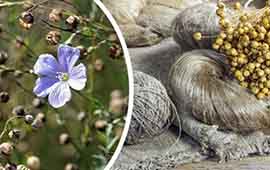Flax is one of the main crops for cultivation and sale in the world market.
The first mention of this plant is known 11 thousand years ago, and even then this culture was actively cultivated and sold. From this plant, fiber, yarn and fabric for the textile industry are obtained, as well as oil and cake for nutrition for both humans and animals. It is known that initially this plant was grown only in China, but at the present stage Europe has become the flagship of these processes.
Europe’s place in the global flax growing market

The cultivation and processing of flax in our time is the prerogative of the EU countries. France, Belgium and the Netherlands have been particularly successful in this. Up to 80% of flax fiber is produced in Europe, so we can confidently say that the EU has taken a strong place in this market. If in France and Belgium they are directly involved in the cultivation of this plant, then countries such as Italy or Germany are also engaged in the import of this crop, since there is equipment for further processing and production of fabrics and yarn.
At the same time, of course, the main supply of flax to the world market, like many centuries before, is carried out by China. This crop is especially popular for import due to the increased interest in environmentally friendly consumption and production – and what else, if not flax, fully satisfies these needs?
By the way, in addition to fiber, an extremely useful oil is obtained from this plant. Flaxseed oil has an excellent effect on the condition of the gastrointestinal tract, helps maintain the functioning of the heart and blood vessels, and also ensures the health of nails and hair. This product is often replaced by other types of oils in cooking, therefore its production remains very profitable, especially for European countries that do not have enough capacity to produce this type of oil. In this case, the seeds of this plant are already exported. By the way, even the countries of Europe, where this plant is actively grown, are eagerly buying its harvest in other countries.

Thus, Belgium, China and Germany are the main importers of flax seeds and oil of this plant. In addition, the global export of flaxseed oil is estimated at about $ 235 million, which makes the production of this product extremely profitable.
Growing features
To get this plant, you need to know the features of its cultivation, of which, by the way, there are not so many. This culture is unpretentious in care, especially loves dry and warm weather during the appearance of seeds. It must be sown in April so that the soil warms up to +7 degrees. Organic fertilizers must be applied on the site, and during cultivation, it is allowed to use EM preparations that help to improve the structure of the soil. The crop can be harvested by August – by the way, it is enough to simply dry it, and not to process it additionally after harvesting. Already in this form, flax can be sold for export, observing the requirements for the quality of the plant. You can get acquainted with the features of harvesting plants for export in the documents that are presented on the website of the Customs Union.






